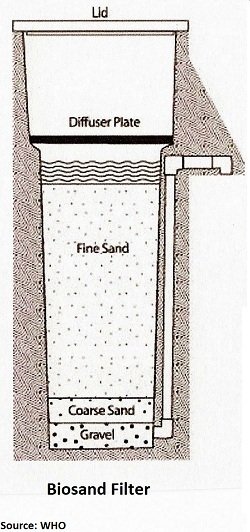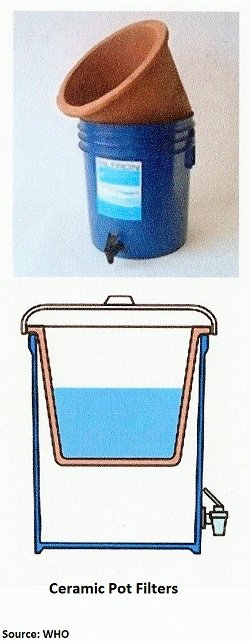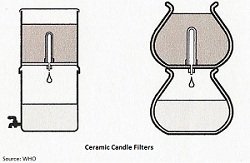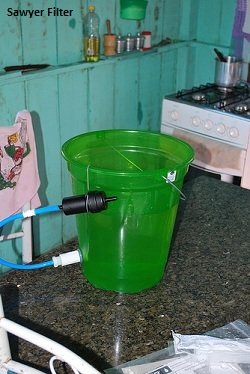The Best Water Filter to Use Depends On Factors Such as Cost, Effectiveness, and Available Materials, and Cultural Acceptance
The best water filter for any situation will depend on factors such as cost, effectiveness, and materials available, as well as the required filter effectiveness.
Note: The content on this page has been adapted from publications of World Health Organization (WHO) and Centre for Affordable Water and Sanitation Technology (CAWST).

We'll look briefly at the qualities and characteristics of the following filter types: This may help in determining the best water filter for a given situation.
* Cloth Filters
* Biosand Filters
* Kanchan Arsenic Filters
* Ceramic Pot Filters
* Ceramic Cartridge/Candle Filters
* Hollow Fiber Membrane Filters (Sawyer Filters)
How Does a Cloth Filter Work?
A clean piece of cloth can be used to strain sand, silt, clay and some pathogens out of water. You can use any cotton cloth that is fine and tightly woven, such as a sari cloth.
The cloth should be folded into a few layers and tied over a clean container. Afterwards, you should wash the cloth with clean water before using it again.
Effectiveness
* Quality: Not the best water filter. Least effective filter for removing turbidity and pathogens
* Quantity: Depends on the size of container being used
* Local water: Can be used with any water source
Appropriateness
* Local availability: cloth is available around the world, can recycle old clothes
* Time: Flow rate is fast
* Operation and maintenance: Simple; cloth needs to be washed with clean water
* Lifespan: cloth may need to be replaced
Acceptability
* Taste, smell, color: May be improved
* Ease of use: Very easy
Cost
* Initial purchase cost: Free or low cost since households can use old clothes as filters
* Operating cost: None
How Does a Biosand Filter Work?
A biosand filter is a concrete or plastic box that is filled with layers of sand and gravel. Water is simply poured into the top of the filter and collected in a safe storage container. Pathogens and turbidity are removed by physical and biological processes in the filter sand.

A biosand filter may be the best water filter in places where the materials for construction are available.
Effectiveness
* Quality: Very effective in removing turbidity and pathogens
* Quantity: Can filter 12-18 litres each batch; recommend to use 1-4 times each day to ensure effective pathogen removal
* Local water: Can be used with any water source, may need to sediment water before filtering
Appropriateness
* Local availability: For the best water filter, concrete filters can be constructed anywhere in the world; plastic filters are imported from the United States
* Time: Concrete filter flow rate is 0.6 liters/minute; plastic tilter flow rate is 0.8 liters/minute
* Operation and maintenance: Simple maintenance to clean sand when the flow rate slows down
* Lifespan: Concrete filters 30+ years', plastic filters 10+ years', lids and diffusers may need to be replaced
Acceptability
* Taste, smell, color: Usually improved
* Ease of use: Easy for adults; may be difficult for small children to pour water into the filter
Cost
* Initial purchase cost: US$12-30 for concrete filters; US$75 for plastic filters
* Operating cost: None
How Does a Kanchan Arsenic Filter Work?
The Kanchan Arsenic Filter is an adaption of the biosand filter. It is a concrete or plastic box that is filled with layers of sand and gravel. There is also a layer of rusty nails. The iron oxide in the nails make the best water filter for removing arsenic.
Brick chips are used on top of the nails to keep them from moving around. Pathogens and turbidity are removed by physical and biological processes in the filter sand.
Water is simply poured into the top of the filter and collected in a safe storage container.
Effectiveness
* Quality: Best water filter for removing arsenic. Also removes turbidity and pathogens
* Quantity: Can filter 12-18 litres each batch; recommend to use 1-2 times each day to ensure effective arsenic removal
* Local water: Can be used with any water source; may need to sediment water before filtering
Appropriateness
* Local availability: Concrete filters can be constructed any where in the world; plastic filters are imported from the United States
* Time: Concrete filter flow rate is 0.6 liters/minute; plastic filter flow rate is 0.8 liters/minute
* Operation and maintenance: Simple maintenance to clean sand when the flow rate slows down
* Lifespan: Concrete filters 30+ years', plastic filters 10 + years; nails need to be replaced every 2-3 years to ensure effective arsenic removal; lids and diffusers may need to be replaced
Acceptability
* Taste. smell. color: Usually improved
* Ease of use: Easy for adults; may be difficult for small children to pour water into the filter
Cost
* Initial purchase cost: US$12-30 for concrete filters; US$75 for plastic filters
* Operating cost: None
How Does a Ceramic Pot Filter Work?
Ceramic pot filters are usually made from clay mixed with a combustible material like sawdust, rice husks or coffee husks. Colloidal silver is sometimes used to help with pathogen removal.
A ceramic pot filter may me the best water filter where materials for biosand filters are not available.
Water is poured into a ceramic pot, and is collected in another container that has a tap at the bottom. This system also provides safe storage until it the water is used.

Effectiveness
* Quality: Very effective in removing turbidity and pathogens; provides safe storage to prevent recontamination
* Quantity: Can filter up to 8 liters each batch
* Local water: Can be used with any water source, may need to sediment water before using the filter
Appropriateness
* Local availability: Can be manufactured and purchased locally
* Time: Flow rate is 1-3 liters/hour
* Operation and maintenance: Simple maintenance to clean the pot when the flow rate slows down
* Lifespan: Up to 5 years generally 1-2 years; needs to be replaced if there are visible cracks
Acceptability
* Taste, smell, color: Usually improved
* Ease of use: Very easy
Cost
* Initial purchase cost; US$12-25
* Operating cost: None
How Does a Ceramic Cartridge/Candle Filter Work?
Ceramic cartridge or ceramic candle filters are hollow cylinders that are usually made from clay mixed with a combustible material like sawdust, rice husks or coffee husks.

A ceramic cartridge/candle fiter may me the best water filter where materials for biosand filters are not available.
Colloidal silver is sometimes used to help with pathogen removal. One or more candles are attached into the bottom of a container.
Water is poured into the container and flows through the cartridge or candle, and, in the case of a candle filter, is collected in another container that has a tap at the bottom.
Effectiveness
* Quality: Can be very effective in removing turbidity and pathogens; quality varies depending on the manufacturer; provides safe storage to prevent recontamination
* Quantity: Can filter up to 10 liters of water
* Local water: Can be used with any water source, may need to sediment water before using the filter
Appropriateness
* Local availability: Can be manufactured and purchased locally
* Time: Flow rate is 0.1-1 liter/hour
* Operation and maintenance: Simple maintenance to clean the candle when the flow rate slows down
* Lifespan: Up to 3 years; usually 6 months to 1 year; cartridge or candle needs to be replaced if there are visible cracks or leaks
Acceptability
* Taste, smell, color: Filtered water has improved taste, smell and color
* Ease of use: Easy
Cost
* Initial purchase cost; US$15-30
* Operating cost: none
How Does a Hollow Fiber Membrane (dialysis technology) Filter Work?
These filters are proprietary and are developed and sold by Sawyer Products at www.sawyerpointonefilters.com Using technology taken from

kidney dialysis, these water filters use a collection of “hollow fiber membranes”. The filters are comprised of tiny "U" shaped micro tubes that allow water to enter into their core through tiny micro pores.
The pores are so small (0.1 micron) that no bacteria, protozoa, or cysts like E.Coli, Cholera and Typhoid can get through.
Water is poured into a container, such as a bucket and flows through a tube to the filter. Once the water passes through the hollow fiber membranes, it is collected in another container for safe storage.
Effectiveness
* Quality: Can be very effective in removing pathogens; settling is recommended since turbid water can introduce sediment that could block the pores; high flow rate reduces need to store water
* Quantity: Can filter up to 1 liter of water per minute. These may be the best water filter in terms of flow rate.
* Local water: Can be used with any water source, may need to settle turbid water before using the filter
Appropriateness
* Local availability: Cannot be manufactured but may be purchased locally
* Time: Flow rate is 1 liter/minute
* Operation and maintenance: Simple maintenance to clean the filter when the flow rate slows down
* Lifespan: Up to 3 years if cleaned and backwashed regularly
Acceptability
* Taste, smell, color: Filtered water has improved taste, smell and color
* Ease of use: Easy
Cost
* Initial purchase cost; US$50-60
* Operating cost: None
As you can see, there is no one best water filter. A careful assessment of the needs and resources of a specific locale and circumstance will be required in order to determine the approach that is most appropriate.
Return to "Water Treatment" from "Best Water Filter"
Return "Home"









